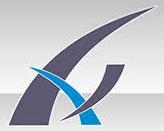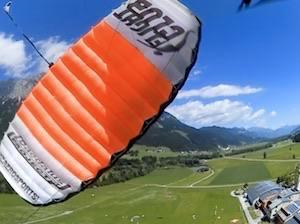

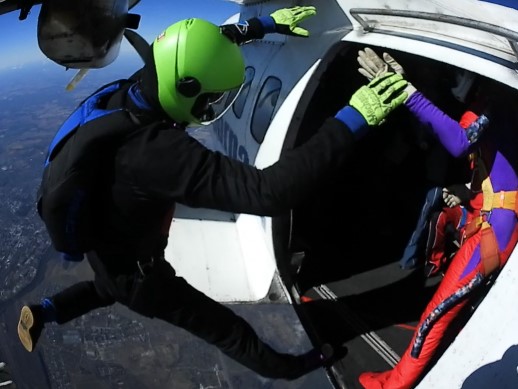

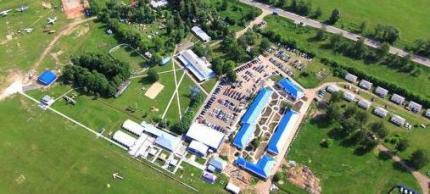
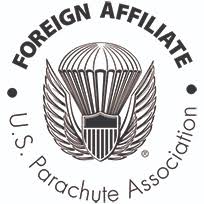
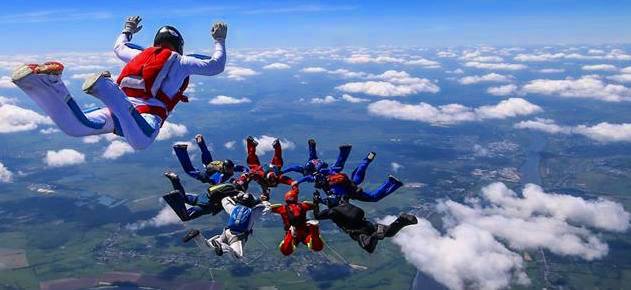
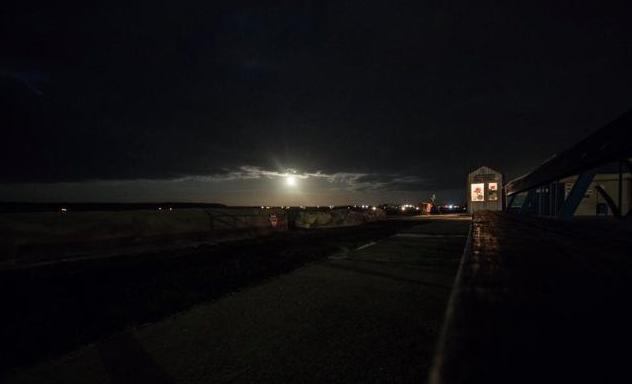
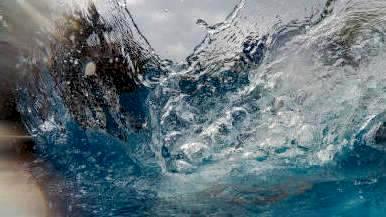
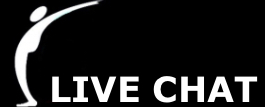

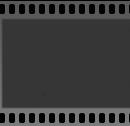
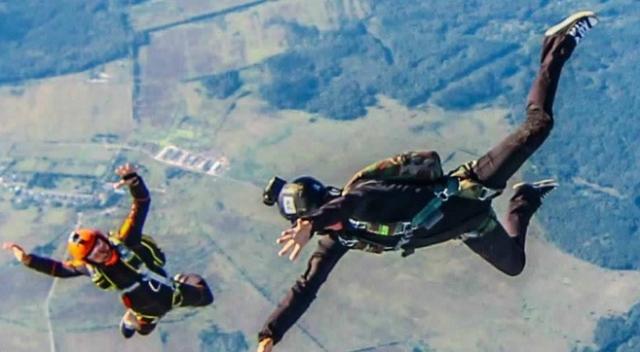
SITE LINKS
CLASSIFICATION OF SKYDIVERS IN THE USPA SYSTEM.
In order to contend for any USPA skydiving license, a jumper must first, following his or her initial student training (such as i.e. an ACCELERATED FREE-FALL COURSE), have been cleared for free-fall self-supervision by an appropriately rated USPA instructor.
Skydivers can then qualify for and receive a variety of different skydiving licenses based on their experience, skill and knowledge level.
Thus, skydiving licenses are essentially, certificates of proficiency. The United States Parachute Association divides these certificates into 4 classes: A-license (entry -stage), B-license (intermediate), C-license (advanced) and D-license (expert).
USPA skydiving licenses are cumulative, meaning you cannot qualify for a B-license if you are not A-license qualified, nor can you get a C-license without being B-license qualified and so on. In order to qualify for any USPA license you must have a current USPA INDIVIDUAL MEMBERSHIP.
All USPA skydiving license holders must comply with the applicable Federal Aviation Regulations (FARs) and comply with USPA Basic Safety Regulations as specified in the USPA SKYDIVER'S INFORMATION MANUAL (SIM).
VALIDITY OF USPA SKYDIVING LICENSES ABROAD.
United States Parachute Association licenses meet or exceed the benchmark proficiency requirements specified by the Federation Aeronautique Internationale (FAI) for International Parachutist Certificates of the same letter (A-, B-, C or D).
The FEDERATION AERONAUTIQUE INTERNATIONALE urges all drop-zone owners around the world to welcome visiting parachutists whose level of expertise in the sport has been certified according to this international standard by their respective FAI member Nation.
In reality, you will be able to skydive with your USPA license in very most countries.
However, FAI member countries do have the right to establish their own licensing standards. It is customary in most places where a regulatory framework does exist, that the National aviation authority governing skydiving activities will request its citizens and permanent residents to cross-convert their USPA license to a National equivalent.
The idea behind this is to get resident skydivers familiarized with local law and to more easily include them into domestic insurance policies.
Since you already do hold a skydiving certificate of proficiency meeting international standard, this process is typically an administrational exercise only.
USPA SKYDIVING LICENSE REQUIREMENTS AND PRIVILEGES.
The following sections specify USPA skydive license pre-requisite criteria and respective license privileges for each USPA skydiving license:
USPA A-LICENSE.
a skydiver holding a USPA A-license may jump without supervision and is allowed to participate in basic group jumps, pack his or her own parachute and perform water landings.
In order to qualify for an USPA A-license, the applicant must:
be a current USPA member, have accumulated >/= 25 freefall skydives, participated in >/= 5 group jumps involving 2 or more skydivers, pass an oral and a written exam, have completed and been signed off on all requirements listed on the USPA A-LICENSE PROFICIENCY CARD.
USPA B-LICENSE.
skydivers holding an USPA B-license are able to exercise all privileges of an A-license holder, perform night jumps and, with >/= 100 jumps, are eligible to contend for the USPA COACH RATING.
In order to qualify for an USPA B-license, the applicant must:
be a current USPA member, have obtained an USPA A-license, completed >/= 50 skydives, logged >/= 30 minutes of free-fall time, landed >/= 10x within a 10m radius from a pre-determined target, pass a written exam, have completed all requirements listed on the USPA canopy piloting proficiency card, have successfully attended live-water training, and prove their in-air skills by documenting successful completion of the planned formations on >/= 10 formation skydives (either RW or free-flying) with >/= 5 of these skydives involving >/= 3 participants.
USPA C-LICENSE.
skydivers holding an USPA C-license are able to exercise all privileges of an B-license holder, are eligible to contend in USPA INSTRUCTOR RATING courses (except Tandem instructor rating course), participate in certain demonstration jumps and are allowed to ride as a passenger on USPA tandem instructor training and rating renewal jumps.
In order to qualify for a USPA C-license, the applicant must:
be a current USPA member, meet all criteria for or have obtained an USPA B-license, completed >/= 200 skydives, logged >/= 60 minutes of free-fall time, landed >/= 25x within a 2m radius from a pre-determined target, pass a written exam, and prove their in-air skills by documenting successful completion of >/= 50 formation skydives (either RW or free-flying) with >/= 10 of these skydives involving >/= 4 participants.
USPA D-LICENSE.
skydivers holding an USPA D-license are able to exercise all privileges of an C-license holder and are eligible to contend for any USPA INSTRUCTOR RATING.
In order to qualify for a USPA D-license, the applicant must be a current USPA member, meet all criteria for or have obtained an USPA C-license, completed >/= 500 skydives, logged >/= 3 hours of free-fall time, pass a written exam, prove their expert-level in-air skills by:
making >/= 2 night-jumps with >/= 20 seconds of free-fall delay each (requires verification and prior briefing by an USPA Safety and Training Advisor), or
providing evidence of having landed within seven feet of the target center on 50 jumps, or
having participated in a canopy formation of a 3 stack or larger, or
having completed an intentional water jump, or
providing evidence of successful completion of one hundred formation skydives, at 25 of which must involve at least eight participants;
USPA SKYDIVING LICENSE
APPLICATION AND PROCESSING.
Once a candidate has successfully met all qualification criteria for the respective USPA license, the USPA LICENSE APPLICATION FORM will be endorsed by an authorized USPA instructor, examiner or Safety and Training Advisor and, together with any proficiency cards, sent to the USPA Safety and Training Department for review and processing.
You should receive the official membership card with upgraded credentials within 30 days in the mail. Those amongst you who simply cannot wait that long, have the option to expedite the license processing request (a small surcharge applies) and your online USPA membership profile will be updated within 48 hours.
HOW TO TRAIN EFFICIENTLY FOR YOUR USPA LICENSE?
Like always in life, you better have a concise plan if you really want to get somewhere. Yet better, you have some fun while you are at it and pick up some skills along the way that serve as a foundation for the future. In skydiving life, that is no different.
In this following section, we will explain what kind of training is required to qualify for USPA A- and USPA B-licenses at the Flight Club skydiving school. Our step-by-step road-map for effective and fun skydive training has taken literally thousands of young skydivers to where they wanted to go:
straight into the skies, flying safely and successfully with their friends.
TRAINING TOWARDS THE USPA A-LICENSE AT THE FLIGHT CLUB SKYDIVING SCHOOL.
YOUR STEP-BY-STEP GUIDE.
Now that you are familiar with the USPA license requirements, it is clear that the actual king-pin item in qualifying for an USPA A-license is the USPA A-LICENSE PROFICIENCY CARD.
Some of the requirements listed on the card will be signed off during your Accelerated Free-Fall course, some others won' t be.
In order to complete the remaining requirements listed on the USPA A-license proficiency card, you should:
complete >/= 5 post-AFF self-supervised solo-skydives;
complete 6 formation skydiving training jumps with a coach;
demonstrate in-air proficiency in 2 A-license graduation jumps;
complete 2 low-altitude jumps (hop'n pops);
learn to pack your own parachute;
pass a written and a final oral exam.
The Flight Club Skydiving School has professional coaches who will work with you in a one-on-one environment to help you accomplish all this. The entire process of completing the USPA A-license proficiency requirements typically takes 3 days.
The all-decisive in-air criteria listed on the proficiency card are the two skydives which require you to "dive a minimum of 100 after another jumper and dock safely without assistance from the other jumper".
In order to make this happen safely and consistently, you must first build a foundation of elementary formation skydiving skills. In simple to complex order, these skills are proximity control and fall-rate control. We teach these skill sets in two separate modules of three skydives each, focusing on the following targeted learning objectives:
USPA A-LICENSE TRAINING SKYDIVES:
SKILL-SET MODULE #1
PROXIMITY CONTROL (3 one-on-one training skydives).
- Rear-float solo exit
- Floater tracking introduction
- Flying a neutral position that allows you to stay in place/
holding still
- Forward motion (6-8 ft) using Start-Coast-Stop principle
- Backward motion (6-8 ft) using Start-Coast-Stop principle
- Grip-taking/ grip release techniques
- Quarterbacking the break-off sequence: the line of flight
- Post-deployment situational awareness: the line of flight
- Introduction to tracking angles: delta vs track
- Increased awareness drills during wave-off/ pull sequence
- Canopy-piloting: negative turns in various brake settings
- Canopy-piloting: vertical stacking in the holding area
- Canopy-piloting: 1/4 brakes and glide angle perception in the
landing pattern
- Landing: increased accuracy requirements (</= 20m)
USPA A-LICENSE TRAINING SKYDIVES:
SKILL-SET MODULE # 2
FALLRATE CONTROL (3 one-on-one skydives).
- Dive solo exit
- Downhill fly-away techniques: delta
- Fall-rate adjustments (4-6 ft.): fast-fall utilizing SCS
principle
- Fall-rate adjustments (4-6 ft.): slow-fall utilizing SCS
principle
- Identifying the no-fly zone
- Fall-rate adjustments (4-6 ft.): fast-fall/ slow-fall
proximity control
- Fall-rate control: forward motion (6-8 ft.) and the final
approach zone
- Fall-rate control: super-positioning (close-range and
medium-range)
- Breaking-off in style: flat tracking technique
- Deployment situational awareness: rear-riser heading
control applied
- Canopy-piloting: introduction to front-riser use
- Canopy-piloting: timing your landing pattern entry
- Landing: increased accuracy requirements (</= 20m)
USPA A-LICENSE GRADUATION.
SKYDIVE # 1:
Dive out of the plane and after your coach with a short delay and come catch him or her in a safe and controlled manner from >/=100 ft away. Most of our students actually end up doing this 3 times before it's time to break-off and deploy.
USPA A-LICENSE GRADUATION.
SKYDIVE # 2:
Dive out of the plane and after your coach with a short delay and come catch him or her in a safe and controlled manner from >/=100 ft away.
Once you docked, release the grip and demonstrate control around three axis, with a loop, a roll and a 360 turn. Identify the line of flight prior to signaling break-off in the assigned altitude, track away >/= 100 feet holding your selected heading and pull stable maintaining this heading throughout the deployment process. Stay out of trouble under canopy and demonstrate a controlled landing respecting your landing priorities …
USPA A-LICENSE GRADUATION.
LOW-ALTITUDE SKYDIVES:
All that remains to be taken care of in terms of in-air proficiency, is for you to show off your new aircraft spotting and exit skills during 2 low-altitude skydives we call "hop'n pops".
To make sure that you won't freeze in low altitude emergency bail-out scenarios and to re-enforce your pull priorities, USPA requires each A-license contender to exit once from 5,500 ft AGL and once from 3,500 ft AGL for a confidence builder.
USPA A-LICENSE TRAINING & CERTIFICATION.
TUITION FEES.
EUR 1,475.00
including: 6 formation-skydiving training-jumps and 2 USPA A-license graduation jumps in one-on-one format with your personal coach, in-air and landing videos of your one-on-one coach jumps, 2 low-altitude solo-jumps, 5 regular-altitude solo-jumps, tuition fees, rig- and accessories rental for 15 skydives, 15 pack-jobs, 1 private packing class in one-on-one format (starting from orientation until you can proficiently pack on your own), USPA A-license exams administration;
For USPA A-license training courses which require our coaches to travel to your home drop-zone, a surcharge applies to compensate expenses for air-fare, transit and accommodation. For USPA A-license training courses administered on drop-zones in Europe or in the Middle East an additional surcharge of EUR 230.00 applies to account for elevated slot prices.
USPA A-LICENSE TRAINING & CERTIFICATION.
SCHEDULING & BOOKING PROCEDURES.
The Flight Club skydiving school in Russia offers USPA A-license training at Aerograd Kolomna 7 days a week, starting from mid-April through mid-October. To schedule your USPA A-license training, please complete and send us the initial BOOKING REQUEST FORM.
Feel free to contact us with any unanswered questions which you might have in FLIGHT CLUB LIVE CHAT.
TRAINING TOWARDS THE USPA B-LICENSE AT THE FLIGHT CLUB SKYDIVING SCHOOL.
YOUR STEP-BY-STEP GUIDE.
The USPA B-license is an intermediate class skydiving certificate of proficiency, which current USPA A-license holders who have accumulated >/= 50 skydives can contend for.
The qualification criteria required to obtain the USPA B-license is heavily geared towards ensuring two main objectives:
to train young skydivers to a higher level of canopy piloting proficiency in order to foster a safe and gradual canopy down-sizing process and
to reinforce plan B survival strategies essential for traveling skydivers jumping over unfamiliar territory. i.e. long spot recovery techniques and handling difficult landing scenarios such as water landing procedures.
Hence, any USPA B-license applicant must complete the USPA CANOPY PILOTING PROFICIENCY CARD and attend a live-water training session.
The Flight Club skydiving school at Aerograd Kolomna regularly hosts USPA B-license training days, where interested skydivers can complete these required training sessions over the course of one single day.
USPA B-LICENSE TRAINING DAY.
SCHEDULE OF EVENTS.
07.00 am - 08.00 am: USPA SIM section 6.5/ 6.11 review
08.30 am - 14.00 pm: canopy piloting training jumps
14.00 pm - 15.00 pm: free-fall proficiency verification jump
15.30 pm - 18.00 pm: live-water training
19.00 pm - 19.30 pm: USPA B-license written exam/ admin
USPA B-LICENSE TRAINING.
FORMAT AND CONTENT.
CANOPY-PILOTING TRAINING JUMPS:
Candidates progress through the 5 canopy-piloting training jumps in the same sequence as outlined on the USPA canopy- piloting proficiency card.
An experienced Flight Club canopy-piloting coach will brief you on each task and come with you on the skydive.
Flying a parachute compatible to yours and equipped with an in-air communication system, your wing man will provide a relative reference during canopy flight drills, provide you with real-time guidance and film your performance up-close from exit to landing.
In addition, you will be wearing a Garmin Fenix %x wrist-mount GPS watch with a live GPS tracking feature.
After landing you will be able to study your canopy flight path on a satellite map in order to perfect your approach and accuracy landing skills.
During the debrief, you'll review your video and GPS data together with your coach in a fun and constructive team environment and the show goes on from there.
USPA B-LICENSE TRAINING.
FREE-FALL PROFICIENCY VERIFICATION JUMP:
Most USPA B-license contenders show up in our office with a logbook or a video documenting their free-fall proficiency.
That is cool and we of course value what we see there. Nevertheless, the first rule in Flight Club is... that's right, you have to fly!
So, we are throwing down the gauntlet and invite each USPA B-license candidate on a one-on-one flight-out, where you can show us your best game. if things check out, we tick the box.
USPA B-LICENSE TRAINING.
LIVE WATER TRAINING:
Unless you have actually landed in the water, you likely have fairly little appreciation for how difficult to handle that might actually be. So, let's get our heads into the game first with some workshop sessions before we get our feet wet!
The USPA B-license live water training session is based on the guidelines specified in the USPA Skydiver's Information Manual (SIM) section 6.5.
USPA B-LICENSE TRAINING.
LIVE WATER TRAINING - WORKSHOPS:
workshop unintentional water landings:
common precursors, early recognition technique, situational awareness, decision making process, body of water specifications, preparation, water entry strategy, variables in the water, 3 levels of response plan
workshop intentional water landings:
planning, equipment, procedure, recovery of jumper and equipment, equipment maintenance
workshop high-performance water landings:
injury prevention, situational awareness, environmental specifics, weight-belts, flotation device, crowd control;
wet training session:
Pool. lake, river or ocean? Depends really. Ideally, a jumper undergoes live-water training starting in a pool before upping the ante and heading out into the wild. Training in realistic conditions and in different environmental conditions is critical to being adequately prepared.
At the Flight Club skydiving school at Aerograd Kolomna, we take first-timers to a shallow clear lake in summer time. Repeat participants can book follow-up sessions in cold water conditions and at the local river.
Your first exercise will be to swim in full skydiving outfit (without the rig) to find out how far you personally can actually make it.
In a second step, we'll throw you into the water wearing a rig, so you can practice your standard water landing procedure in a first level of response.
Once comfortable, participants have the opportunity to practice their second and third level of response plans.
The entire exercise by the way is being monitored by a 2.15m tall and pretty solid Russian life-guard. Everybody can practice within their comfort zone and within their personal abilities in the water. No worries.
USPA B-LICENSE CERTIFICATION.
WRITTEN EXAM.
The written exams are being administered and scored, and your proficiency cards and logbooks endorsed by a USPA Safety and Training Advisor. Once complete, the USPA license application form will be submitted to USPA Safety and Training department for review and processing.
USPA B-LICENSE TRAINING & CERTIFICATION.
TUITION FEES.
EUR 610.00
(including: jump tickets for you and your coach for 5 canopy piloting training jumps and 1 free-fall proficiency verification jump, in-air video footage of your skydives, in-air com system rental fee, Garmin Fenix 5x GPS tracking system rental fee, live-water training, water gear rental fee, tuition fees, B-license processing fees at USPA.
not included: skydiving gear rental (if you do not own equipment yet)
For USPA B-license training days which require our coaches to travel to your home drop-zone, a surcharge applies to compensate expenses for air-fare, transit and accommodation. For USPA B-license training days administered in Europe or in the Middle East, an additional surcharge of EUR 80.00 applies to account for elevated slot prices.
USPA B-LICENSE TRAINING.
SCHEDULING & BOOKING PROCEDURES.
The Flight Club skydiving school in Russia offers USPA B-license training 7 days a week, starting from mid-April through mid-October. To schedule your USPA B-license training at the Flight Club skydiving school, please fill in and send us the initial BOOKING REQUEST FORM.
Speak to us directly about any questions which you might have in FLIGHT CLUB LIVE CHAT.
Did you know that with a USPA B-license and >/= 100 jumps you are eligible to contend for the USPA COACH RATING?
USPA C-LICENSE AND USPA D-LICENSE CERTIFICATION.
AT THE FLIGHT CLUB SKYDIVING SCHOOL.
Contenders for USPA C-licenses and USPA D-licenses can visit the Flight Club skydiving school at Aerograd Kolomna anytime for assistance with the administrational side of their license applications.
Should you need any help to meet the necessary canopy piloting- and/ or in-air qualification criteria, you can hire a Flight Club coach to get you ready in no time. For more information, please visit our comprehensive SKYDIVE COACHING, ORGANIZING, MENTORING tutorial.
Equipped with these new skills, you are ready to go for it and give it a shot: "dive a minimum off 100 after another jumper and dock safely without assistance from the other jumper". You have to demonstrate this ability on two separate skydives:
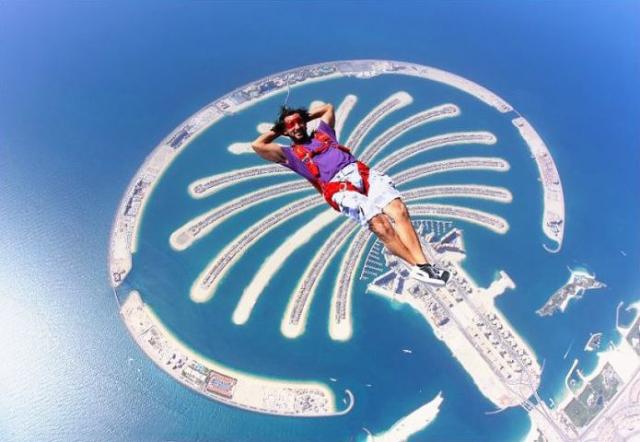

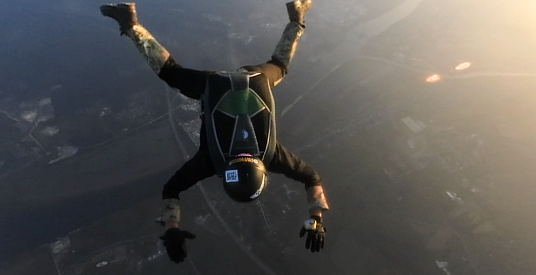
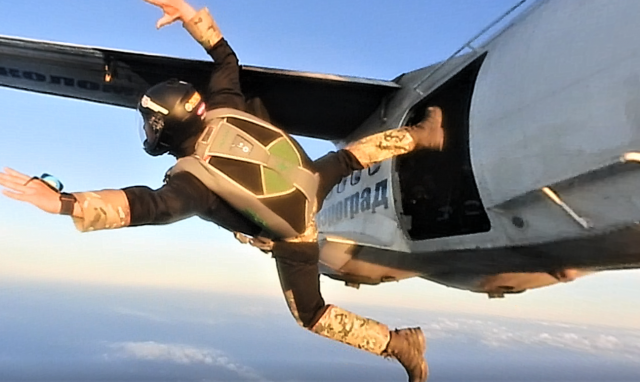
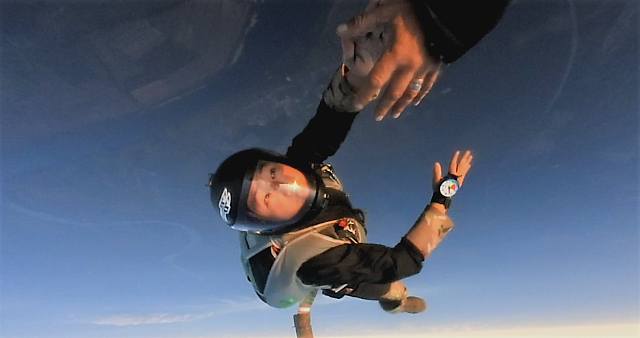
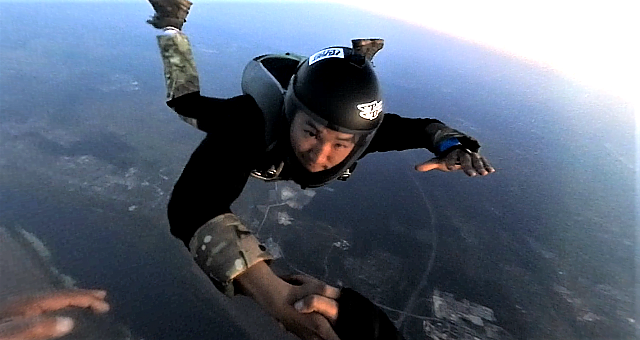
USPA SKYDIVING LICENSES.
TRAINING AND CERTIFICATION AT THE FLIGHT CLUB SKYDIVING SCHOOL IN RUSSIA.
On this page we will explain everything there is to know about the classification of skydivers in the United States Parachute Association (USPA), the validity of USPA skydiving licenses abroad, USPA A-, B-, C- and D-license privileges and associated certification requirements.
In our detailed step-by-step guide we describe what kind of skydive training it involves to meet these requirements and how you can get your own USPA license in Russia with the FLIGHT CLUB SKYDIVING SCHOOL at Aerograd Kolomna.
Our focus lays squarely on getting you started into this exhilarating sport the right way. Accordingly, the emphasis in this tutorial is directed towards the entry-stage qualifications of USPA A- and USPA B-license training. More seasoned skydivers, contending for USPA C-licenses and D-licenses, can contact us for assistance with the administrational side of their license application.
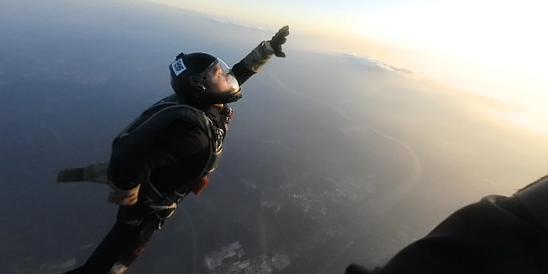
USPA A-LICENSE CERTIFICATION.
EXAMS AND ADMINISTRATION.
Boom! Congratulations! That USPA A-license is pretty much yours already!
Last but not least, it's time to demonstrate your knowledge regarding some BSRs and other rules pertinent to skydiving in a written exam. Provided you score >/= 75%, your instructor will endorse your USPA A-license proficiency card and let you head out into the real world after a final oral exam and after answering any remaining questions which you might have.
Pending the administrational side of actually submitting your documents to USPA safety and Training Department for review and processing, you are now officially a licensed skydiver and can go fly with your friends!
